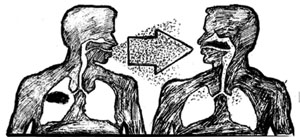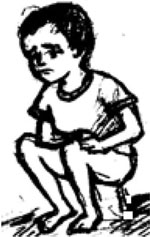Route of exit
Before an infectious agent can be transmitted to other people, it must first get out of the infected host. The site on the infected host through which the infectious agent gets out is called the route of exit. Some common examples are described below.
Respiratory tract
The routes of exit from the respiratory tract are the nose and the mouth. Some infectious agents get out of the infected host in droplets expelled during coughing, sneezing, spitting or talking, and then get transmitted to others (Figure 1.4). For example, people with tuberculosis in their lungs usually have a persistent cough; Mycobacterium tuberculosis uses this as its route of exit.

Gastrointestinal tract

The anus is the route of exit from the gastrointestinal tract (or gut). Some infectious agents leave the human body in the stool or faeces (Figure 1.5). For example, the infectious agents of shigellosis, a disease which can cause bloody diarrhoea, use this route of exit.
Skin
Some types of infectious agents can exit the body through breaks in the skin. For example, this route of exit is used by Plasmodium protozoa, which are present in the blood and get out of the human body when a mosquito bites through the skin to suck blood.